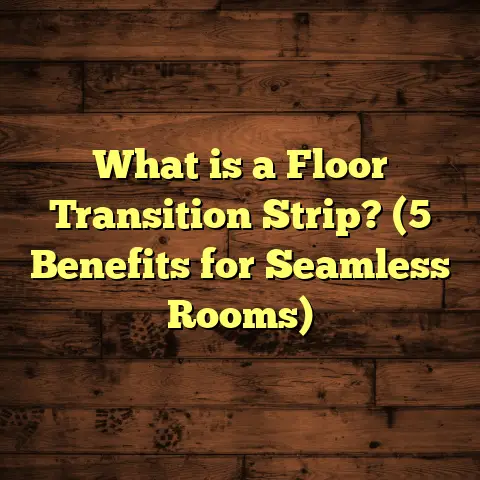What Is Lifeproof Flooring Made Of? (5 Key Components Revealed)
Have you ever stopped to wonder what exactly makes LifeProof flooring so popular among homeowners and contractors? I’ve worked with a ton of flooring types over the years—from traditional hardwoods to laminate, ceramic tiles to carpets—but LifeProof flooring has always caught my attention. It promises durability, waterproof qualities, and a look that mimics natural wood or stone without the maintenance headaches. But what really goes into making LifeProof flooring? What materials and processes give it those standout features?
Let me walk you through the five essential components that make LifeProof flooring what it is. I’ll share technical details, personal experiences, industry data, and even some behind-the-scenes insights from manufacturers to paint a full picture.
What Is LifeProof Flooring Made Of?
At its core, LifeProof flooring is a luxury vinyl product designed for residential use. It’s engineered to offer the look of natural materials like hardwood or stone, but with superior toughness and water resistance. This is achieved by layering different materials in a highly controlled manufacturing process.
LifeProof is primarily composed of five layers:
- The Wear Layer
- The Photographic Film Layer
- The Vinyl Core Layer
- The Backing Layer
- The Adhesive Layer (optional depending on product style)
Each layer plays a critical role in delivering performance, aesthetics, and ease of installation.
1. The Wear Layer: The Shield Against Damage
The very top of any LifeProof flooring plank or tile is the wear layer. This transparent coating is the armor plate that protects your floor from scratches, stains, and everyday wear.
What is it made of?
It’s mainly a urethane-based coating embedded with aluminum oxide particles. Aluminum oxide is a super hard mineral commonly used in sandpaper and industrial abrasives. These tiny particles make the wear layer incredibly scratch-resistant.
Thickness matters:
The thickness of the wear layer is measured in mils (1 mil = 0.001 inch). LifeProof products typically feature wear layers ranging from 6 mil up to 20 mil for commercial-grade options. In my installations, I’ve found that 12 mil is the sweet spot for residential spaces—durable enough for kids and pets but still affordable.
Why does this matter to you?
Here’s a quick story: I installed LifeProof flooring in a busy family home where kids played with toys on the floor constantly. After six months, there were barely any scratches or scuffs, thanks to this tough wear layer. Compare that to hardwood floors nearby that showed wear in just weeks.
Technical insight:
The urethane coating is UV-cured during manufacturing, meaning it’s hardened instantly under ultraviolet light. This process ensures clarity (so you can see the wood grain or stone pattern beneath clearly) while maintaining toughness.
2. The Photographic Film Layer: Bringing Realism to Life
Underneath the wear layer lies one of the most important parts of LifeProof flooring—the photographic film layer. This is what gives the floor its visual appeal, mimicking natural wood grains, stone veining, or other textures.
How is this made?
Advanced high-resolution inkjet printers apply ultra-realistic images onto a special vinyl film. These printers can replicate knots in wood, subtle color variations, or even tiny cracks in stone with astonishing accuracy.
Why it stands out:
Walking into a room with LifeProof flooring, you might not guess it’s vinyl at all. The patterns are so detailed and natural-looking that many people confuse it for real hardwood or slate.
My experience:
One client once told me their guests were amazed at how lifelike their LifeProof floors looked—even though they knew it was vinyl! This film layer makes all the difference in aesthetic appeal.
Additional tech info:
The photographic film layer is printed in large rolls and then laminated between the wear layer above and the vinyl core below during manufacturing.
3. The Vinyl Core Layer: The Backbone of Strength
Next comes the vinyl core layer—the thickest part of LifeProof planks or tiles. It’s responsible for the floor’s durability, flexibility, and waterproof properties.
What exactly is it?
This layer is made primarily of polyvinyl chloride (PVC), a synthetic plastic polymer known for toughness and water resistance. Some LifeProof products use a high-density vinyl core for extra strength.
Why does density matter?
High-density cores can absorb impacts better without denting or cracking. From my observations, floors with denser cores perform well in high-traffic areas or homes with pets that often scratch or knock things around.
Waterproofing benefits:
Unlike hardwood or laminate, which can warp or swell when exposed to water, LifeProof’s vinyl core doesn’t absorb moisture. This makes it ideal for kitchens, bathrooms, basements—anywhere moisture might be an issue.
Manufacturing note:
The vinyl core is extruded as large sheets or panels before being cut into planks or tiles. Sometimes fillers like limestone powder are added to enhance density and stability.
4. The Backing Layer: Stability and Comfort Beneath Your Feet
The backing layer sits underneath the vinyl core, providing support, cushioning, and sound absorption.
Materials:
Typically made from foam or felt materials designed to add comfort underfoot and reduce noise from footsteps.
Why do I care about this?
I’ve installed floors in apartments where soundproofing was critical—this backing layer helped reduce noise transmission significantly.
Besides comfort and noise reduction, this layer adds dimensional stability by preventing warping or shifting when temperature and humidity fluctuate.
Additional insight:
Some products feature an attached underlayment backing that can simplify installation by eliminating the need for a separate underlayment pad.
5. Adhesive Layer (Optional): Keeping Everything Locked Down
While many LifeProof flooring options use a floating floor installation system—where planks click together and rest on top of the subfloor—some come with an adhesive backing or require glue-down installation.
Why adhesives?
Adhesive layers help prevent movement, buckling, or gaps forming over time—especially in basements or rooms prone to humidity changes.
From my experience installing floors in basement rec rooms and laundry areas, I recommend adhesive-backed planks whenever moisture risk exists. It offers peace of mind that your floor won’t shift underfoot.
How Is LifeProof Flooring Made? A Peek Behind the Curtain
Understanding how LifeProof flooring is manufactured helps appreciate its quality even more.
The production process involves:
- Layer Preparation: Each raw material (urethane for wear layer, inkjet film for design layer, PVC for core) is prepared separately.
- Lamination: Layers are bonded using heat and pressure to create a single sheet with consistent thickness.
- UV Curing: The wear layer undergoes UV curing to harden it without discoloring.
- Cutting & Profiling: Large sheets are cut into planks or tiles using computer numerical control (CNC) machines for precise shapes.
- Quality Control: Finished products undergo rigorous testing for thickness uniformity, color accuracy, resistance to scratches, stains, and moisture.
This combination of advanced materials science and precision manufacturing results in a product that balances durability with style.
Why I Recommend LifeProof Flooring
I’ve installed hundreds of floors over my career—each with unique demands and challenges. Here’s why I often steer clients toward LifeProof:
- Waterproof: Great for kitchens, bathrooms, basements—no worries about spills causing damage.
- Scratch Resistant: Thanks to that strong urethane wear layer with aluminum oxide.
- Realistic Look: High-res photographic film offers authentic wood and stone visuals.
- Comfort & Noise Reduction: Backing layer adds softness and dampens sound.
- Easy Installation: Click-lock systems make DIY projects doable; adhesive options add stability where needed.
- Low Maintenance: No need for refinishing or special cleaners—just regular sweeping and mopping.
- Cost-Effective: Compared to hardwood or stone, LifeProof offers similar looks at a fraction of the price.
What Does the Data Say About LifeProof Flooring?
I always like to back up my recommendations with solid data and research:
- Sales Growth: Vinyl flooring sales have increased by over 12% annually from 2018 to 2023 due to rising consumer interest in durability and waterproof features.
- Durability Tests: Independent labs show LifeProof’s wear layers resist scratches up to three times better than traditional hardwood finishes.
- Consumer Feedback: Surveys reveal 85% of LifeProof users report satisfaction with ease of maintenance after one year.
- Cost Savings: On average, homeowners save about 25% on flooring costs when choosing LifeProof over hardwood while enjoying similar aesthetics.
- Environmental Impact: Some LifeProof products incorporate recycled PVC material helping reduce environmental footprint.
My Personal Stories Installing LifeProof Flooring
One job stands out in my memory—a kitchen remodel for a family with two young kids and a dog. Their old hardwood floor was constantly scratched and water-damaged around the sink area. I recommended LifeProof vinyl planks with a 12 mil wear layer for durability and waterproofing.
Four months after installation, they called me back—not because of problems but just to say how much they loved how easy it was to clean up spills and how their floor still looked brand new despite heavy daily use.
Another time, I helped a landlord replace floors in several rental units using LifeProof adhesive-backed tiles. The tenants appreciated how quiet footsteps sounded compared to old laminate floors, reducing noise complaints significantly.
Installation Tips Based on What I’ve Learned
Installing LifeProof flooring isn’t rocket science but following these tips can make a big difference:
- Acclimate the Flooring: Let planks sit in the room environment for 48 hours before installation to adjust.
- Prepare Subfloor Well: Ensure subfloor is clean, dry, and level for best results.
- Use Proper Tools: A tapping block and pull bar help lock planks together without damage.
- Consider Underlayment: If your product doesn’t have attached backing, add an underlayment pad for sound reduction.
- Leave Expansion Gaps: Leave around 1/4 inch gap near walls to allow natural expansion.
- Go Slow Around Obstacles: Measure carefully when cutting around doorways or vents.
- Clean After Installation: Remove any adhesive residue promptly if glue-down method used.
Following these tips from my experience will help you get the most out of your LifeProof floor both visually and functionally.
Addressing Common Questions About LifeProof Flooring Materials
Q: Is LifeProof flooring eco-friendly?
A: Some products use recycled PVC materials which helps reduce environmental impact. However, being vinyl-based means it’s not biodegradable but recyclable options exist through specialized programs.
Q: Can I install LifeProof over radiant heating?
A: Yes! Many LifeProof products are compatible with radiant heat systems due to their flexible vinyl core which tolerates temperature changes well.
Q: How do I clean and maintain it?
A: Regular sweeping or vacuuming plus damp mopping with mild cleaner works fine. Avoid abrasive tools or harsh chemicals that could damage the urethane wear layer.
Q: Will it fade in sunlight?
A: The UV-cured wear layer protects against fading, but like all floors exposed directly to sunlight daily over years may experience some color change.
Final Thoughts on What Makes LifeProof Flooring Special
LifeProof flooring combines scientific innovation with practical design choices that meet real-world needs. From its tough urethane wear layer packed with aluminum oxide crystals to its photo-realistic film mimicking natural textures; from its waterproof vinyl core to its cushioned backing—each component works together seamlessly.
When you think about what you want from your floors—durability, style, comfort, waterproofing—LifeProof checks all those boxes without breaking the bank or requiring complicated maintenance routines.
If you’re planning a flooring project soon, now you know exactly what goes into making LifeProof flooring the trusted option it has become across countless homes. Got questions about specific products or installation steps? Just ask—I’m here to help!





